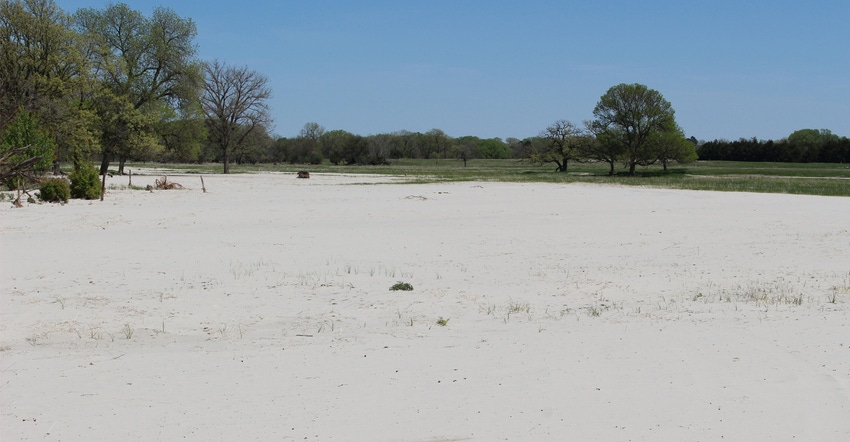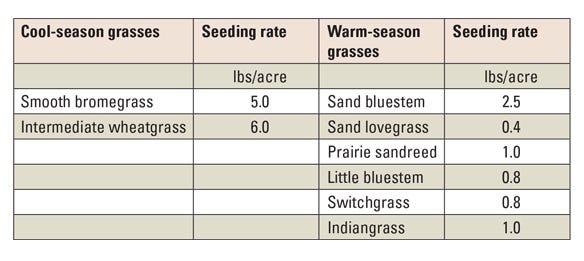April 3, 2020

Early-spring flooding in 2019 across much of the western Corn Belt was widespread and damaging. The extent and depth of sand deposited after the water receded was not expected after the flooding.
The amount of sand deposited in many areas prevented removal or spreading. This is one of the remaining obstacles across many acres of grazing land and cropland.
Managing sand deposits
Shallow sand deposits (less than 2 inches deep) had little or very low impact on perennial grass growth. These areas did see some early growth from many perennial grasses that were capable of producing new shoots and tillers if sand deposited across pastureland was less than 2 inches.
Moderate deposits (between 2 and 8 inches) and heavy sand deposits (more than 8 and 10 inches) required either spreading or removal to enhance recovery. In many instances, revegetation with perennial grass may be the only remaining option for the extremely deep sand deposits.
Goals for perennial grass revegetation of heavy sand deposits include:
stabilize sand deposits
add organic matter
bring grasslands into production

RECOMMENDED MIXES: Recommended cool- and warm-season perennial grass mixtures for revegetating heavy sand deposits.

Revegetation guidelines
Revegetating heavy sand deposits may require two years to stabilize sand deposits and improve soil organic matter before planting perennial grasses during the third year. A suitable spring and fall cover crop, such as oats, can be used to stabilize the deep sand deposits and add organic matter.
A summer annual cover crop, such as millets, can be planted and grown during summer months for stabilization and adding soil organic matter.
When revegetating flood-damaged pastures, especially those with heavy sand deposits, it is important to consider perennial forages that are adapted to sandy soils.
An acceptable cool-season perennial grass mixture that would be broadly adapted would be smooth bromegrass (planted at 6 pounds of seed per acre) blended with intermediate wheatgrass (5 pounds per acre).
This could be spring-seeded in April or late summer-seeded in late August (if soil moisture is available). Oats planted at 5 to 10 pounds of seed per acre can help reduce weed competition during establishment.
Suitable warm-season perennial grass mixtures can be more diverse with species adapted to sandy sites dominating the mixture.
Planting sand bluestem (2.5 pounds of seed per acre), sand lovegrass (0.4 pounds per acre), prairie sandreed (1.0 pounds per acre), little bluestem (0.8 pounds per acre), switchgrass (0.8 pounds per acre) and indiangrass (1.0 pounds per acre) in early May or during the dormant season is recommended.
Similar to the cool-season perennial mixture, oats can be planted at 5 to 10 pounds of seed per acre to help reduce weed competition during establishment.
Redfearn is a Nebraska Extension forage and crop residue specialist.
About the Author(s)
You May Also Like




